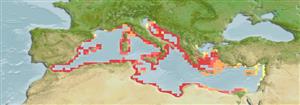Teleostei (teleosts) >
Anguilliformes (Eels and morays) >
Ophichthidae (Snake eels) > Ophichthinae
Etymology: Ophichthus: Greek, ophis = serpent + Greek, ichthys = fish (Ref. 45335).
More on author: Rafinesque.
Environment: milieu / climate zone / depth range / distribution range
Ecology
Marine; demersal; depth range 90 - 130 m (Ref. 122751). Subtropical; 45°N - 30°N, 6°W - 36°E
Endemic to the Mediterranean.
Size / Weight / Age
Maturity: Lm ? range ? - ? cm
Max length : 60.0 cm TL male/unsexed; (Ref. 3397)
Found on the shelf, on mud bottoms (Ref. 3397). A nocturnally-active species (Ref. 48389). Buries itself in the mud during the day, emerging only to feed at night (Ref. 48389).
Bauchot, M.-L., 1987. Poissons osseux. p. 891-1421. In W. Fischer, M.L. Bauchot and M. Schneider (eds.) Fiches FAO d'identification pour les besoins de la pêche. (rev. 1). Méditerranée et mer Noire. Zone de pêche 37. Vol. II. Commission des Communautés Européennes and FAO, Rome. (Ref. 3397)
IUCN Red List Status (Ref. 130435)
Threat to humans
Harmless
Human uses
More information
Age/SizeGrowthLength-weightLength-lengthLength-frequenciesMorphometricsMorphologyLarvaeLarval dynamicsRecruitmentAbundanceBRUVS
ReferencesAquacultureAquaculture profileStrainsGeneticsElectrophoresesHeritabilityDiseasesProcessingNutrientsMass conversion
Tools
Special reports
Download XML
Internet sources
Estimates based on models
Preferred temperature (Ref.
123201): 17.7 - 21.4, mean 19.2 °C (based on 452 cells).
Phylogenetic diversity index (Ref.
82804): PD
50 = 0.5000 [Uniqueness, from 0.5 = low to 2.0 = high].
Bayesian length-weight: a=0.00089 (0.00039 - 0.00204), b=3.00 (2.80 - 3.20), in cm total length, based on LWR estimates for this (Sub)family-body shape (Ref.
93245).
Trophic level (Ref.
69278): 4.3 ±0.5 se; based on diet studies.
Resilience (Ref.
120179): Medium, minimum population doubling time 1.4 - 4.4 years (Preliminary K or Fecundity.).
Fishing Vulnerability (Ref.
59153): Moderate vulnerability (44 of 100).
Nutrients (Ref.
124155): Calcium = 47.6 [11.1, 143.4] mg/100g; Iron = 1.09 [0.42, 4.27] mg/100g; Protein = 18.7 [16.5, 21.2] %; Omega3 = 0.325 [0.151, 0.907] g/100g; Selenium = 24.9 [4.8, 70.8] μg/100g; VitaminA = 15.3 [4.5, 53.9] μg/100g; Zinc = 0.514 [0.258, 1.021] mg/100g (wet weight);
